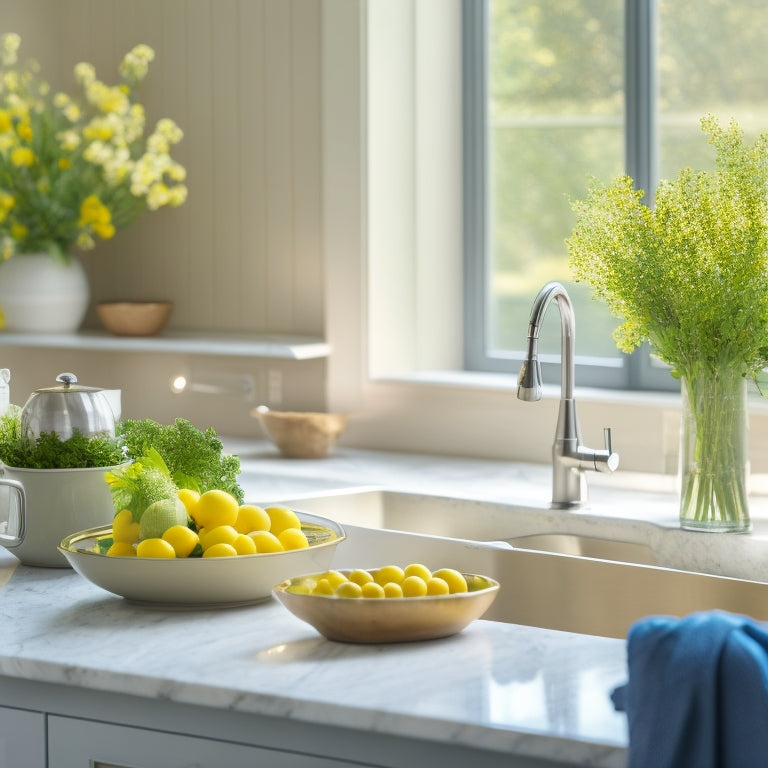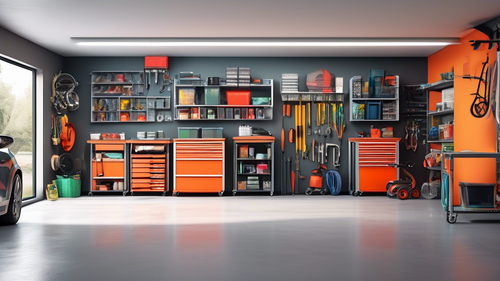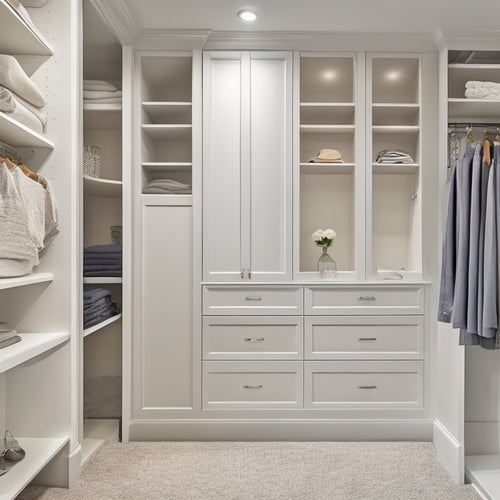
What If Your Kitchen Cleaning Was a Breeze?
Share
You can achieve a kitchen where cleaning is a breeze by implementing a few simple strategies that streamline your workflow, maximize storage, and maintain organization. Start by clearing off countertops, designating zones for specific tasks, and purging unnecessary items. Organize your sink and stove areas, refrigerator space, and coffee station to make meal prep and cooking a snap. Assign a home for utensils, maintain your cabinet space, and keep your floor clear. Finally, tame your 'junk drawer' and get ready to breathe a sigh of relief every time you step into your kitchen - and that's just the beginning.
Key Takeaways
• Clear off countertops and sort items into categories to maintain control and visibility, making cleaning a breeze.
• Implement a meal prep station and assign specific zones for each category to simplify surfaces and reduce clutter.
• Purge unnecessary items from cabinets, drawers, and countertops to reduce cleaning time and effort.
• Establish a routine for daily floor care, including sweeping or vacuuming, and weekly mopping with a microfiber mop.
• Designate specific areas for coffee, baking, and utensils, and use dividers or containers to separate items, promoting efficient cleaning.
Zone 1: Countertop Organization
Start by clearing everything off your countertops and sorting items into categories, such as baking supplies, cooking utensils, and appliances, to create a sense of control and visibility. This is the foundation of a well-organized kitchen.
Next, designate specific zones for each category. For instance, assign a spice rack to a specific area, making it easily accessible when you need it. Consider implementing a meal prep station, where you can chop, dice, and prepare ingredients for future meals. This will save you time and reduce clutter.
Once you've categorized and zoned your countertops, it's time to purge what's unnecessary. Be ruthless – if you haven't used it in the past year, it's probably safe to get rid of it. This will help maintain your newfound sense of control and visibility.
Streamlining Sink and Stove Areas
By focusing on the sink and stove areas, you'll tackle the heart of your kitchen's functionality, where messes and clutter can quickly accumulate. These spaces are prone to chaos, but with a few simple strategies, you can streamline them and make cleaning a breeze.
Here are some actionable tips to get you started:
-
Sink Organization: Install a sink organizer or tray to corral soap, sponges, and scrubbers, keeping them out of sight and within reach. This will create a sense of calm and make cleaning up spills a snap.
-
Stove Cleanliness: Clean your stove daily to prevent grime buildup. Remove food debris and wipe down burners, drip pans, and the cooktop with a gentle cleanser.
-
Decluttering Dishes: Store frequently used dishes in easy-to-reach locations, and consider a dish rack with built-in utensil storage to keep countertops clear.
- Simplifying Surfaces: Remove any unnecessary items from countertops, and group similar items together (e.g., coffee maker, sugar, and creamer). This will create a sense of flow and make cleaning a whole lot easier.
Taming the Refrigerator Space
Now that you've streamlined your sink and stove areas, turn your attention to the refrigerator, where expired or spoiled food can quickly clutter up your kitchen and spoil your appetite. It's time to tame this space and make meal prep a breeze.
Start by purging your fridge of expired or spoiled items, and wipe down the shelves with a gentle cleaner. Next, implement a fridge organization system that works for you, using baskets or bins to categorize and store food. Consider designating a specific shelf for meal prep items, like pre-cut veggies or marinated proteins, to make healthy eating easier.
Don't forget to check your food storage habits, too - are you using your pantry space efficiently? By optimizing your pantry organization, you'll be able to find what you need quickly and easily, reducing food waste and saving time.
With a little effort, you can turn your fridge into a hub of efficiency and productivity, making meal prep and cooking a whole lot easier.
Designating a Coffee Station
When you designate a coffee station in your kitchen, you're creating a hub that makes your morning routine more efficient.
By keeping your coffee essentials within reach, you'll save time and reduce clutter.
Now, let's explore how to organize your station, choose the right stationery and accessories, and make the most of this valuable space.
Coffee Essentials Within Reach
Designate a specific area of your countertop as a coffee station to keep all your coffee essentials within easy reach. This will save you time and energy in the morning, and make your daily routine more efficient. By having everything you need in one spot, you can focus on perfecting your brewing techniques, rather than searching for misplaced items.
Here are the must-haves for your coffee station:
-
Coffee bean storage: Keep your favorite beans fresh and within reach in an airtight container.
-
Coffee maker: Choose a machine that fits your brewing style, whether it's a drip brewer, French press, or pour-over.
-
Mugs and accessories: Store your favorite mugs, creamers, and sweeteners in easy-to-access locations.
- Syrups and flavorings: Keep your favorite flavorings, such as vanilla or hazelnut, nearby to add a twist to your daily cup.
Coffee Station Organization Tips
To maximize the functionality of your coffee station, assign a specific zone on your countertop to each essential item, ensuring a seamless workflow and effortless morning routine. This means designating a spot for your coffee maker, grinder, and brewer, as well as storage for your coffee beans and mugs.
Group your coffee-related items into categories, such as brewing, storage, and serving. For instance, place your coffee maker and grinder near each other, and store your coffee beans in an airtight container nearby.
Designate a specific area for your mug collection, keeping them within easy reach. Consider a mug tree or a decorative mug rack to keep them organized and add a touch of style to your coffee station.
Stationery and Accessories
You'll also want to ponder the stationery and accessories that complement your coffee station, like a coffee-themed notepad, a set of matching coasters, and a few favorite coffee-table books that evoke the perfect morning ambiance. These thoughtful touches will elevate your coffee station from functional to inviting.
To create a cohesive look, consider the following desk essentials:
-
A paper tray to keep your paper organization in check, storing notebooks, journals, and recipe printouts within easy reach.
-
A desk calendar to stay on top of appointments and deadlines.
-
A pen holder to keep your writing utensils tidy and organized.
- A small notebook dedicated to jotting down coffee-inspired recipes or notes.
Creating a Baking Zone
Set aside a specific area, ideally near a heat source, where you can centralize your baking essentials, freeing up counter space and streamlining your baking process. This baking zone will become your go-to spot for whipping up a storm.
Start by organizing your spices using a tiered spice rack or a magnetic board. This will keep your frequently used spices within easy reach, saving you time and reducing clutter.
Next, gather your baking essentials, such as mixing bowls, measuring cups, and utensils, and store them in designated containers or baskets. This will create a sense of control and efficiency, allowing you to focus on the task at hand.
With your baking zone in place, you'll be able to tackle even the most complex recipes with confidence. Imagine having all your ingredients and tools at your fingertips, ready to create culinary masterpieces with ease.
Maximizing Cabinet Storage
When it comes to maximizing cabinet storage, you'll want to focus on making the most of every inch.
You can start by optimizing your shelf space, which will help you fit more items in without overcrowding.
Optimize Shelf Space
Your kitchen's cabinet space is a valuable real estate that deserves careful planning to guarantee every item has a designated spot, making meal prep and cleanup a breeze. By optimizing your shelf space, you'll reduce clutter, increase efficiency, and make cooking a joy.
Here are some practical tips to get you started:
-
Pantry organization: Assign a specific shelf for dry goods, and consider a spice rack to keep frequently used spices within easy reach.
-
Double-layer storage: Install wall-mounted shelves or hanging baskets to maximize vertical storage and keep less frequently used items out of the way.
-
Label and categorize: Label each shelf and category to secure everything has a designated spot, making it easy to find what you need when you need it.
- Store heavy items below: Keep heavy pots and pans on lower shelves to prevent them from falling and to make them easier to access.
Utilize Corner Areas
Now that you've optimized your shelf space, turn your attention to the often-wasted corner areas of your cabinets, where clever storage solutions can access even more space. Corner organization is key to maximizing space in your kitchen. By utilizing these areas, you can create hidden storage and reduce clutter.
Here are some creative solutions to get you started:
| Corner Storage Solution | Description |
| Carousel Corner Shelf | Rotating shelf for easy access to items |
| Blind Corner Organizer | Sliding baskets for hidden storage |
| Corner Drawer Organizer | Adjustable dividers for customized storage |
| Lazy Susan Corner Cabinet | Rotating tray for easy access to items |
| Corner Basket Organizer | Wicker baskets for decorative storage |
These solutions can help you make the most of your kitchen's corner areas. By incorporating one or more of these ideas, you'll be able to store more items in a smaller space, keeping your kitchen organized and clutter-free. With a little creativity, you can turn these often-wasted areas into valuable storage space.
Assigning a Home for Utensils
Designate a specific drawer or container near your cooking station as the utensil hub, where you'll store frequently used items like spatulas, whisks, and tongs. This will save you time and energy when cooking, as you'll have everything you need within easy reach.
To take your utensil organization to the next level, consider the following:
-
Use drawer dividers to separate utensils by type or frequency of use, keeping similar items together and making them easy to find.
-
Invest in an utensil caddy to store items like spoons, spatulas, and whisks, keeping them upright and organized.
-
Label your utensil hub so you can quickly identify what's inside, even when you're in a hurry.
- Keep only the essentials in your utensil hub, storing less frequently used items in a separate area to avoid clutter.
Keeping the Floor Clear
Every minute counts in a busy kitchen, and tripping over clutter on the floor can be a major time-waster. To keep your kitchen floor clear, you need to establish a routine for floor care. Start by sweeping or vacuuming the floor daily to remove crumbs, dust, and dirt. Then, mop the floor at least once a week using effective mopping techniques. Use a microfiber mop and a gentle cleaning solution to get the job done efficiently.
Choosing the right mats and rugs can also make a big difference. Place mats at high-traffic areas, such as in front of the sink and stove, to catch spills and crumbs. Rugs with rubber backing can provide extra grip and prevent slipping. Additionally, consider using a central mat or rug to define the kitchen area and add warmth.
Mastering the "Junk Drawer"
You're probably familiar with the cluttered drawer in your kitchen that's overflowing with takeout menus, broken appliances, and who-knows-what-else, making it a challenge to find what you need when you need it. This 'junk drawer' is a common kitchen phenomenon, but it doesn't have to be a source of frustration. With a few simple steps, you can master your junk drawer and turn it into a tidy and functional space.
Here are some decluttering tips to get you started:
-
Purge the unnecessary: Sort through the contents of your drawer and get rid of anything you don't need or use.
-
Categorize and group: Organize items into categories, such as cooking utensils, batteries, and cords, and group them together.
-
Assign a home: Designate a specific spot in the drawer for each category, making it easy to find what you need.
- Use dividers: Use dividers or small containers to separate items and keep them from getting jumbled together.
Frequently Asked Questions
Can I Use a Dishwasher to Sanitize My Kitchen Utensils and Tools?
You can use a dishwasher to sanitize kitchen utensils and tools, leveraging its hot water and soap to kill bacteria; however, for items that can't be washed, consider alternative sanitizing methods like soaking in vinegar or bleach solutions.
How Often Should I Deep Clean My Kitchen to Maintain Cleanliness?
Imagine walking into a sparkling kitchen, free from crumbs and clutter. To maintain this haven, create a monthly schedule with a cleaning checklist, and take preventative measures with daily maintenance, ensuring your kitchen shines like new.
Are There Any Eco-Friendly Kitchen Cleaning Products I Can Use?
You're looking for eco-friendly kitchen cleaning products! Opt for natural alternatives like baking soda, vinegar, and lemon juice, or choose sustainable options like Seventh Generation, Ecover, or Method, which are gentle on surfaces and the environment.
Can I Use Baking Soda and Vinegar for All Kitchen Cleaning Tasks?
You're thinking, "Can I really use baking soda and vinegar for all kitchen cleaning tasks?" Yes, you can! Try baking soda alternatives like washing soda or borax, and vinegar hacks like diluting it with water for natural cleaning solutions and DIY recipes.
How Do I Get Rid of Stubborn Grease Stains on My Kitchen Countertops?
You tackle stubborn grease stains on your kitchen countertops by mixing baking soda and water to form a paste, applying it to the stain, and letting it sit before wiping clean with a gentle countertop cleaner.
Related Posts
-

Maximize Your Garage Space: A Comprehensive Guide
Decluttering and organizing your garage can seem like a daunting task, but it's a worthwhile investment that will...
-

What Makes a Custom Closet Storage System Perfect?
When it comes to creating a perfect custom closet storage system, you need a balance of form and function. You want t...

